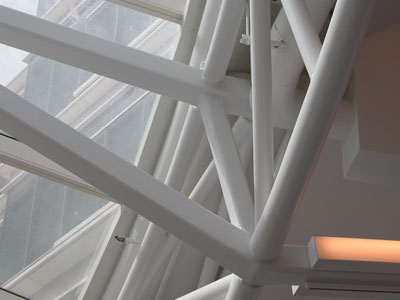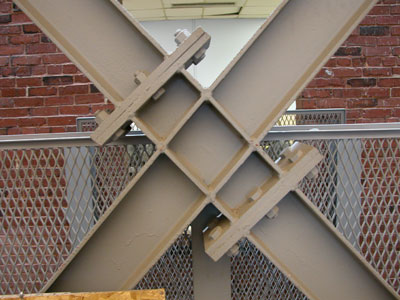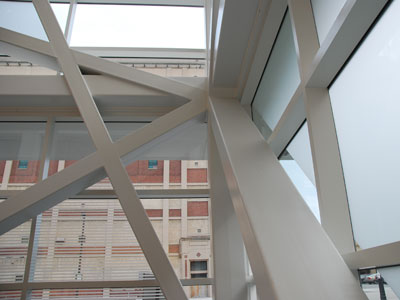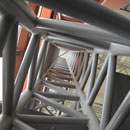Architecturally Exposed Structural Steel
AESS Connection Requirements
This section will briefly touch on some of the main issues with AESS connection requirements. Each of these sections will be looked at in more detail in the INNOVATIVE CONNECTIONS section of this website.
ARCHITECTURALLY EXPOSED STRUCTURAL STEEL: PART FOUR
Custom Connections
Sponsored by the American Collegiate Schools of Architecture (ACSA)
General Issues
AESS structures, by their inherently exposed nature, put a greater than normal emphasis on the design of connections. The detailing language of the connections must feed into the overall aesthetic desired for the structure, as well as be constructable and within reason to erect. Although the details that are normally used for AESS structures include some fairly standard connection methods, these are mostly modified as a way of enhancing the Architectural expression of the structure, and by their nature are likely to present challenges for both fabrication and erection.
Connection types can be sudivided by structures that use "shapes" (such as W, C and L shapes), and those that use hollow sections. These typologies can be further subdivided by the choice to predominantly weld or bolt the connections. Plates can be worked into both types of connections. AESS connections will often incorporate specialty items such as rods and tensile connectors.
In turn there are shop fabricated connections and site/erected connections. As a general rule it is better to maximize the number of connections, particularly welded connections, that can be done in the shop over those, usually bolted, that must be done on site. There is more quality control in the shop. Jigs can be set up for repetitive assemblies which will ensure consistency in appearance and finish. It is easier to turn and fix the members into position for welding with crane assist. The application of primer and even finish painting is more efficiently done in the shop.
In the end, the maximum size of member that can be transported to site will often determine the scope of shop fabricated connections and the number and type that must be done on site. Although it is possible to transport oversized pieces to the site with a Police escort, it does increase the cost of the project. Likewise, when the site is constricted and the staging area either small or non existent, pre-assembling of pieces on site on the ground might also not be possible. Most urban sites will require "just in time" delivery of steel pieces and carefully planned erection to make the best use of the staging area as well as preserve area for staging that might be required to the last moment of steel erection.
Hidden or discrete connections can be used where there are transportation and erection limitations. If a standard bolted connection is unsatisfactory from an aesthetic point of view, and a welded site connection is impractical and expensive, alternatives can be provided. Large pieces can be transported and erected efficiently using bolted connections that are hidden or that are made discrete.
Connection Mock-Ups
The issue of Mock-Ups (Characteristic 2.1 Visual Samples) plays heavily into the design issues related to connections. Most Architects would ideally like to be able to see and feel specialty connections before they commit to their mass fabrication. This is not always possible or practical due to issues of timing and cost. The fabrication of large specialty items is expensive and time consuming. Physical mock-ups can create delays, not only by their fabrication but also to have all parties present for approvals. Viewing distance needs also to be taken into account when looking at a physical mock-up. Normally those present are examining the sample at close range when in fact the in situ connection may be many metres out of range of view and touch. The AESS Category must be kept in mind when viewing physical samples. It may be possible to verify most of the appearance issues associated with the connections and receive design approval through the use of 3-D drawings - a combination of those that are produced by the Fabricator's detailing software and ones that are produced with 3-D modeling software. This approach can same time and money. It may also be possible to reference a Fabricator's previous work to establish a baseline for discussion when using digital references.
If 3D or other sorts of digital models are to be used as the basis of agreement for details, it is important to discuss the finer aspects of welding, bolting and finishing as these are likely not represented fully in the digital model.
A combination of smaller physical mock-ups of aspects of detailing and finish might be used to accompany digital representations to achieve a good level of communication about the expectations of the project details.
Which Type of Connection Should I Choose?
 |
This truss is finished with a heavier intumescent fire protective coating. As this would mask any very fine detail or sharp edges, the welded connections and rounded section types chosen work well with the finish. |
The connection type will be dependent on the structural requirements of the assemblies, the shapes and types of steel members that are to be connected as well as the aesthetic that is desired. The type of connection that is the most appropriate for a project might not be clearly evident from the outset. As previously mentioned, there are many different types of connections and it may be necessary as well as desirable to use different types in a project as are suited to the specific range of requirements, AESS Categories (recognizing that viewing distances throughout a project may vary). For overall clarity of the design these different connections may use a similar language and form a "family" of typical conditions.
As with any project the overall structural considerations - loads, clear spanning requirements and support location - will form the starting point for the design. More pragmatic issues such as the type of project, use of the space, exposure to weather and atmospheric grime and choice of fire protection method will begin to influence the choice of AESS Category. There is little economic sense investing in highly articulated details if the connections are either out of view or concealed in part by thicker intumescent coatings. If there is significant dirt present in the environment, or if cleaning and maintenance of the structure is difficult, it is best not to create ledges that will collect dirt and surfaces that will highlight lack of maintenance.
Transportation and access to the site will begin to necessitate breaking up the overall concept into smaller elements that may be shipped as well as fit into erection limitations on the site. The majority of site connections tend to be bolted. This does not preclude the use of welded connections on site. Site welding does mean additional costs to put temporary shoring or supporting pieces in place while welding is carried out, and remove and make good surfaces when these are no longer required. It is also possible to suggest aesthetically pleasing bolted connections.
Budget will also directly impact detailing. If the project can be broken into different Categories of AESS, then the more visible areas can be more expensively detailed. Refer both to the Matrix for suggested cost premiums for the AESS Categories as well as discuss the same with your Fabricator.
Bolted Connections
 |
Bolted connections can be used in AESS structures to obtain a more technical look to the steel, or used in conjunction with welded connections as a means to simplify erection. |
Bolted connections are normally chosen to achieve a more rugged aesthetic to the AESS or as a result of erection issues and constraints. Bolted connections are often chosen when using W, C or L shapes. The more industrial look of these section types seems more aesthetically suited to bolted connections. Often the detailing used on these types of bolted AESS connections is very close to the same connections that would be used in Standard Structural Steel. The organization and alignment of the members is likely to be either more careful or more creative than is to be found in Standard Structural Steel.
When designing bolted connections it is within the right of the design to specify the type of bolt to be used (Characteristic 1.4) as well as the consistency of the side on which the bolt head is to be found. As the structural requirements of the bolted connection dictate how far it needs to be tightened it is not reasonable to expect the rotation of all heads to align.
You can also find bolted connections used with hollow structural members. The typical "practical" HSS connection is to weld the intersecting HSS elements in the shop and create stubs with oversized end plates to facilitate erection. If these end plates are not aesthetically satisfying, cap plates and plates slit into the HSS can be detailed to make the connections more discrete. These details are automatically more expensive.
Welded Connections
 |
Welded connections are used where a very clean appearance is desired. Here, square HSS sections have been welded so that there are virtually no visible lines indicating which member passes through the connection and which has been attached. Obviously this requires a high level of workmanship and additional costs for grinding and filling. |
Shop welded connections are used on a high proportion of AESS structures. Welding gives a clean, uncluttered appearance. Welding is often used on hollow structural shapes, and less often for W, C or L shapes. That is not to say that welding is not used with W shapes.
Welded connections present different challenges for the Fabricator as a function of the "geometry" of the connection as it is combined with the choice of member. For complex geometries to be more affordable and for better quality and alignment, it will be necessary to maximize the amount of work that can be done in the fabricator's plant so that proper jigs, lifting and clamping devices can be used to manipulate the materials. It will be necessary to understand transportation restrictions when working through the details of these connections. There will be a maximum member size that will be able to clear bridge overpasses and road widths as not to result in clearance mishaps or frequent police escorts or road closures. Where highly articulated assemblies must be broken into smaller elements due to transportation and lifting limitations, it will be helpful to discuss the details of these more significant site connections with the fabricator if a totally welded "appearance" is the desired end result. It is possible to create site connections that give the appearance of being welded but that are discretely bolted, the final connection concealed with cover plates.
When deciding upon the level of finish of a welded connection it is extremely important that the viewing distance and AESS Type and associated Characteristics be respected. One of the major reasons for cost overruns in AESS has historically been the tendency of welded connections to be overworked. Welds are often ground, filled or smoothed out unnecessarily. Welds are structural and overgrinding of welds can diminish their strength. Only in Custom or very high end AESS 4 should grinding be considered as an option for welded connections. Except in the instance of structural necessity, or for seal welding to prevent moisture entry, welding may not even need to be continuous.
When looking at the ultimate requirements for AESS welding it is important to understand the purpose of the connection that is being welded and the limitations of fabrication. Here some plates have been welded to the base of a column to add stiffness to the connection. The welds have been well done and smoothed out in preparation for painting. They have not been made to disappear. |
The final finish on the column is a high gloss paint. This was also taken into consideration when preparing the welds as this type of finish is very unforgiving. Had the element been located further from view or not finished to AESS4 standards, less remedial work would have been possible for these welds. |
